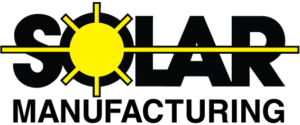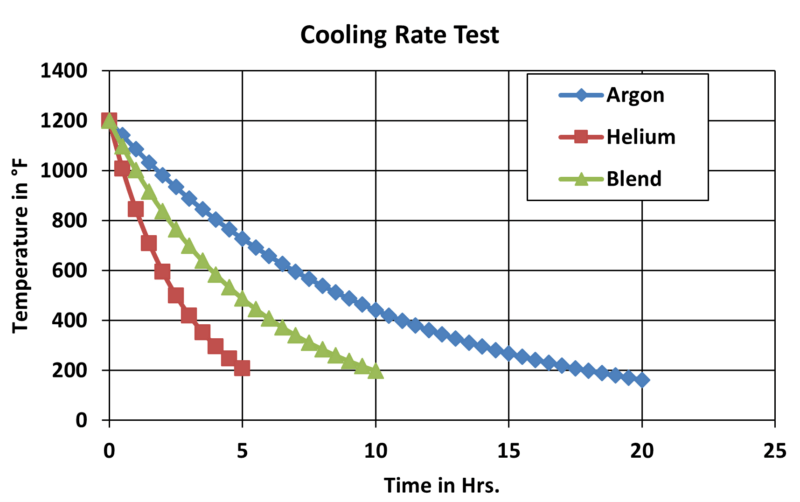Blended Gases – A Cost-Effective Alternative To Helium In Processing Reactive Metals
Introduction
Argon and helium gases have been used and evaluated as quench gases within vacuum heat treating circles for many years. These totally inert gases are the only choices that are available to the heat treater processing reactive metals such as titanium, zirconium, tantalum, and their alloys. Decades of research show that the cooling rates for helium are far better than those of argon. However, a current government policy dilemma is likely to have far-reaching repercussions for the future.
Problem
Scientists have recently warned that helium, one of the world’s most commonly used inert gases, is being depleted at astonishing rates. What has caused this shortage of the second lightest element in the universe? One has to look no further than our own United States Government.
In 1996, the US passed a law1 stipulating that the US National Helium Reserve, the largest store of helium in the world, located outside of Amarillo Texas, must sell off all its inventory by 2015, irrespective of the market price. The law also dictates that an equal amount must be sold each year, regardless of global demand.
Since our earth has taken 4.7 billion years to accumulate our helium reserves, and there is no artificial way to manufacture the gas, many scientists predict the world will run out of helium within 25 to 30 years. It is inevitable, therefore, that heat treaters purchasing helium will see costs rise exponentially unless the US Government reconsiders its policy of selling off US national helium reserves.
Solution

Historically, when vacuum processing large, 55,000 pound loads of titanium coils, Solar Atmospheres of Western Pennsylvania would typically utilize 100% helium as the backfill gas of choice. As the prices for helium escalated, a proposed solution was to sacrifice the more efficient cooling rates by using a less expensive inert gas: argon. It was quickly realized that using such a dense gas for cooling heavy loads was a huge mistake.
In 1992, Air Products and Chemicals US Patent #5,173,124 discovered that cooling rates resulting from blending helium and argon together in specified ratios would be greater than those from helium alone under similar conditions of turbulent flow. The patent was also based on the cooling results of a rather small load of 1,844 pounds. Solar Atmospheres of Western PA decided to perform similar experiments on very large loads in excess of 50,000 pounds.
Test

A total of six (6) two bar quenching tests were performed in a 5′ x 5′ x 24′ long Solar Manufacturing patented car bottom designed vacuum furnace (See Photo 1). Each furnace load consisted of a cast workload grid and special customer-supplied fixturing base plates weighing a total of 6,125 pounds. The normal weight of each titanium coil was 10,000 pounds. Each five-coil load therefore equaled a total weight of 56,125 pounds. Temperature measurements were taken from three (3) work thermocouples firmly embedded in the innermost core of the center coil. (See Photo on right)
The first two cooling tests performed utilized a backfill of each of the pure inert gases alone. Cooling speed with 100% helium versus 100% argon on identical loads was faster by a factor of four (five hours versus 20 hours). Cooling these massive workloads was enhanced by over-speeding the two 300HP blower motors with variable frequency drives (VFD). These VFD’s allow the motors to perform at a maximum motor current that adapts to the type of process gas selected. The use of argon at two bar allows the motors to operate at approximately 3000 rpm, whereas the less dense helium allows the motors to operate at 5000 rpm at only one third of the motor current needed for argon. Another promising method of enhancing cooling time was to control the backfill make-up gas. In all of the tests, once the chamber was backfilled to two bar pressure, and cooling was initiated, no additional make-up gases were added, thereby conserving cooling gas. As the temperature in the furnace decreased, the chamber pressure also decreased. This pressure drop allowed the frequency drives to speed up the motors, providing faster velocities through the gas nozzles.
The next four cooling tests consisted of various ratios of the two gases in the blend. The initial blend test was 20% argon-80% helium, which was similar to the optimum blend cited in the Air Products patent. The total cooling time averaged 10 hours. The next test used a 50/50 blend of argon and helium. The total cooling time again was 10 hours. The next test used 80% argon-20% helium. The cooling rate remained at 10 hours. The last test, in an effort to save as many helium molecules as possible, tested a 90% argon-10% helium mix. The cooling rate surprisingly remained the same as with all of the previous blends. The chart below summarizes the results and costs associated with each backfill:
| Blend | Cooling Time | Backfill Costs | Electricity2 | Total Cost |
| 100% Argon | 20 Hours | $350.00 | $800.00 | $1,150.00 |
| 100% Helium | 5 Hours | $1,250.00 | $100.00 | $1350.00 |
| 20% Argon 80% Helium | 10 Hours | $1,050.00 | $200.00 | $1,250.00 |
| 50% Argon 50% Helium | 10 Hours | $800.00 | $300.00 | $1,150.00 |
| 80% Argon 20% Helium | 10 Hours | $350.00 | $400.00 | $750.00 |
| 90 % Argon 10% Helium | 10 Hours | $300.00 | $400.00 | $700.00 |
Conclusion
Although the thermal conductivity of helium is ten times that of argon, there is a cumulative dynamic effect on the quantity of heat transmitted when blending gases, independent of the ratios. For the immediate future, Solar Atmospheres is employing this characteristic to backfill automatically at a 90% argon-10% helium mixture3, with no additional make-up gas during the ten hours of cooling.
The future for the use of helium is certainly very bleak. In fact at the time of this writing, our gas supplier4 imposed a helium force majeure measure upon us. These helium allocations will definitely last until the end of 2012- if not beyond. Even if helium gas supplies do not vanish completely, the cost will become extremely prohibitive. Not only will heat treaters be severely affected, but other industries such as medical (MRI scanners), aerospace (rockets and air ships), and welding operations will also be impacted.
Author: Robert Hill, Jr., President, Solar Atmospheres of Western PA
Notes:
- Public Law 104-273, Helium Privatization Act of 1996.
- Based on kWh to drive cooling motors.
- Patent pending
- Air Products and Chemicals, Inc. of Allentown, PA

